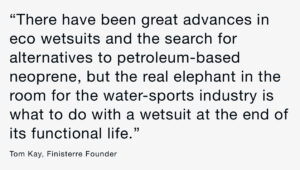Finisterre – Wet suits from wet suits
Finisterre wanted to solve the problem of old wetsuits and what we do with them, as they are either in the corner of peoples garage or shed somewhere unused for years, or they’re in landfill not breaking down. The UK alone creates 380 tonnes of wetsuits which end up in landfill. The issue with wetsuits is that they have quite a tough job to do, so they have to be designed accordingly. They need to keep the human body dry and insulated, so they can withstand ice cold temperatures of the waters, they also need to be able to protect the body slightly from a fall off a surfboard or a cliff jump etc, which if done wrongly can feel like you’re hitting a slab of ice or a brick wall; therefore they have quite a tough design brief.

Swimming in fresh water or the ocean has many benefits, the biggest one being positive benefits on peoples mental health. I’ve struggled with my mental health for a few years now and I fell in love with wild swimming because I loved to be able to submerge my head into cold waters and have all the thoughts and feelings disappear for a while. I had always done all my swimming just in a bikini because I loved the feeling of the cold water on my skin, but a couple of years ago, in North Berwick, I almost got hypothermia. It suddenly became very important to me that swimming through the winter months should probably be done with some form of thermal insulator.
However, wetsuits are not very environmentally friendly at all, they are made from petroleum-based neoprene, very chemically based materials. Finisterre wanted to look for an alternative to this material, or not have to use anymore of it and so came wetsuits from wetsuits. They created the first eco wetsuit made out of bio-rubber. However, this didn’t solve the issue of all the wetsuits that were already in existence and so they wanted to push the boundary further. They partnered up with Exeter University in 2017 to use/improve the first ever wetsuit recycler. Unlike other objects/appliances which have adapted and changed designs over and over for years, wetsuits have been made in the same way since the 1950s, neoprene being at the centre of their design. Hopefully now with this revolutionary bit of kit, the wetsuit recycler, we should see more and more reused materials rather than new ones.





Recent comments